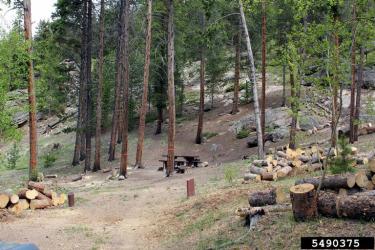Your Checklist for Mountain Pine Beetle Prevention
Thinning trees, like in this campground in Colorado, can help prevent pine beetle attacks.
There are some things you can do to help your woods avoid—or survive—an attack by mountain pine beetles.
- Preventive Sprays. If mountain pine beetles are in your area but haven’t yet attacked your trees, you can spray trees before the bark beetles hatch in summer. If spraying is done right, it is very effective at protecting trees from new attacks.
- Pheromones. Pheromones are chemical signals that insects use to communicate. Putting out artificial pheromones can disrupt mountain pine beetles by making it harder for them to communicate with each other. This works best when there aren’t very many mountain pine beetles around.
- Don't move firewood. Mountain pine beetles can lurk in healthy-looking firewood, so don’t transport firewood over long distances. If you turn your own infested trees into firewood, mark them so you remember to burn them before the new adult beetles emerge in summer.
- Thin trees...maybe. Mountain pine beetles are most attracted to lodgepole pines, which grow in dense stands. Thinning can make lodgepoles less susceptible to beetles but can also make the remaining trees more likely to blow down. Ponderosa pines, on the other hand, are much more able to resist mountain pine beetle attack if they’ve been thinned. Thinning works best if done several years before mountain pine beetles arrive, so it’s never too early to think about whether it makes sense for your woods. Talk to your local extension agent or forester about whether you should thin your trees.
- Start fresh. If mountain pine beetles have already destroyed your woods, you have a chance to grow a healthy new stand of trees. Thinning young trees will help them grow up at a safe density. A stand with trees of many ages will be more resistant to mountain pine beetle attack.
Whether you’re trying to prevent an infestation or controlling damage from an existing infestation, you don’t have to go it alone. State, county or consulting foresters, the Forest Service or your local cooperative extension service can all help you protect your woods and preserve your forest legacy.
Previous page
How can I get more tips?
It’s simple! Enter your email below.

